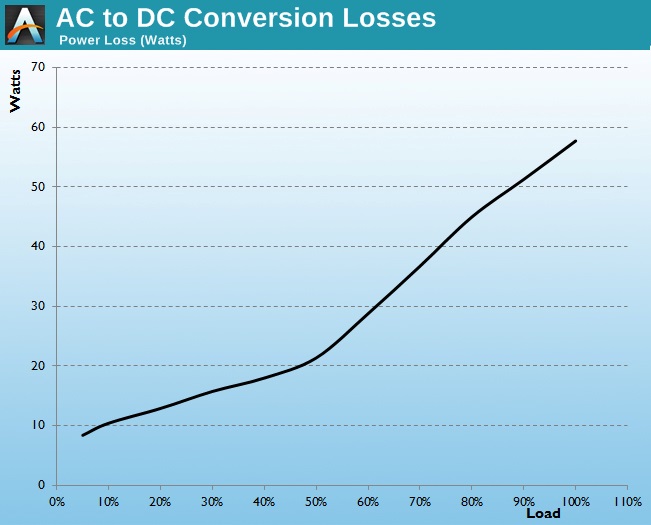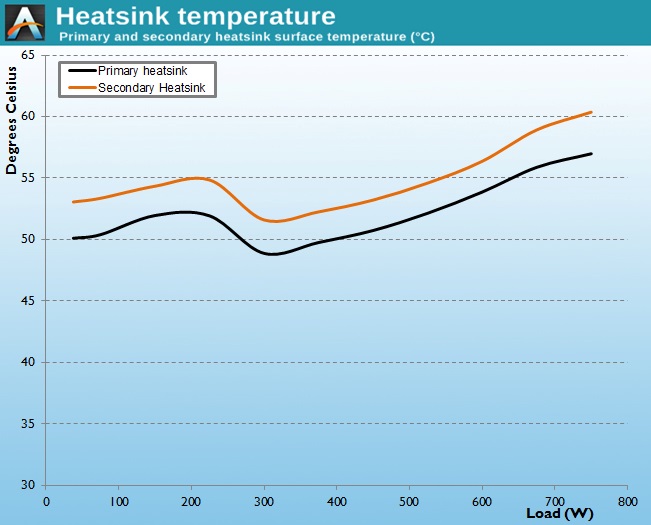Corsair HX750i Power Supply Review
by E. Fylladitakis on January 14, 2015 10:00 AM EST- Posted in
- Cases/Cooling/PSUs
- Corsair
- PSUs
- HXi Series
Cold Test Results
For testing PSUs, we use high precision electronic loads with a maximum power draw of 2700 Watts, a Rigol DS5042M 40 MHz oscilloscope, an Extech 380803 power analyzer, two high precision UNI-T UT-325 digital thermometers, an Extech HD600 SPL meter, a self-designed hotbox, and various other bits and parts. For a thorough explanation of our testing methodology and more details on our equipment, please refer to our How We Test PSUs – 2014 Pipeline post.
Honoring its 80 Plus Platinum certification, the Corsair HX750i displays outstanding performance at room temperature. The peak efficiency is 94.3% at 50% load and the average within the nominal load range (20% to 100% of the unit's capacity) is an astonishing 92.9%. The HX750i performs well under low loads as well, with the efficiency plummeting only when the load is less than 50 Watts.
The very high efficiency of the HX750i combined with the hybrid fan design allows the HX750i to operate with its fan turned off with a load up to about 300 Watts. After that, the fan will start but the power supply will remain essentially quiet with a load up to 600 Watts. Only when the load exceeds that point does the fan becomes clearly audible, yet it never reaches the point where we would consider it loud -- especially if it's housed in a closed case.















32 Comments
View All Comments
icebox - Wednesday, January 14, 2015 - link
I had this for a few months now, it's an excellent PSU.But I'm curious about which way it should be mounted:
Fan side up so heat can escape easily when the fan is off or fan side down ?
RedEye9 - Wednesday, January 14, 2015 - link
I have a bottom mounted 750 watt corsair ps with a load/temp activated fan. It would cycle when mounted fan side down to blow out accumulated heat. I turned it fan side up and the fan never cycles. (silence)jonnyGURU - Friday, January 16, 2015 - link
^^ This. Fan down and the heat will rise into the PSU PCB until the fan kicks in. Fan up and the heat rises out of the PSU housing and the fan will hardly ever kick in.While the Corsair marketing says that the PSU's fan doesn't turn on until 30% load, that really depends on multiple conditions. The fan controller used in these uses an algorithm of load, temperature and duration to determine when the fan should turn on and at what speed.
EzioAs - Wednesday, January 14, 2015 - link
Doesn't really matter actually but if your chassis has a filtered bottom intake, might as well mount it with the fan facing down.Strunf - Thursday, January 15, 2015 - link
Better with the fan facing up as you said the heat will escape easily and the fan will hardly ever spin since you don't use too much power most of the time.malkolm - Wednesday, January 14, 2015 - link
Nice review, thx for it!Actually i do not agree with you mentioning, that a 750W System is intrinsically so load that the noise of a PSU doesnt matter at all. I dont know if it's a european thing, but at least here the ultra-low noise market is growing extraordinarily, meaning more and more people are build machines, even their top-end gaming rigs, and demand it to be litteraly inaudible.
Really big tower coolers, custom GPU designs and of course custom water cooling (again a rapidly growing market in the EU) help with this, but the one thing most people end with is the annoying scenario of having the PSU left as the only source of noise. Of course one can buy one of these semi-passive devices designed for 1500Watts to power their 600Watts gaming rig just to make sure its fan doesnt start to run, but thats not a viable option for most users.
There are only a few companies who had an ear for those users, with beQuiet! (German brand/company i think) beeing to most renown and most recommended manufacturer for this market. I guess Corsair is also good advised to focus more on their accoustics.
Kutark - Wednesday, January 14, 2015 - link
Using a 1500w PSU to make it more silent is just irresponsible. PSU's have much better efficiency when they're between about 40 and 70% load. Getting a 1500w psu like that, despite the additional cost with buying, generally means you will be operating at a load level that is moderately to highly inefficient.Dr.Neale - Saturday, January 17, 2015 - link
Not if you get a 80+ Titanium rated semi-passive 1500W PSU, e.g. Corsair AX1500i. It's very, very quiet (with the fan facing upwards, of course).Of course, the 80+ Platinum SeaSonic 520W fanless PSU (SS-520FL2) is totally silent, with no coil whine to speak of, and 1/3 the price. It's good for a quiet single-GPU build.
N.B. Low ripple is especially important for the longevity of your computer components. And the lower the ripple, the higher the quality, and price.
That's my experience, anyway.
EzioAs - Wednesday, January 14, 2015 - link
Doesn't really matter actually but if your chassis has a filtered bottom intake, might as well mount it with the fan facing down.EzioAs - Wednesday, January 14, 2015 - link
I was actually trying to reply to icebox...when are we going to get an edit fuction?